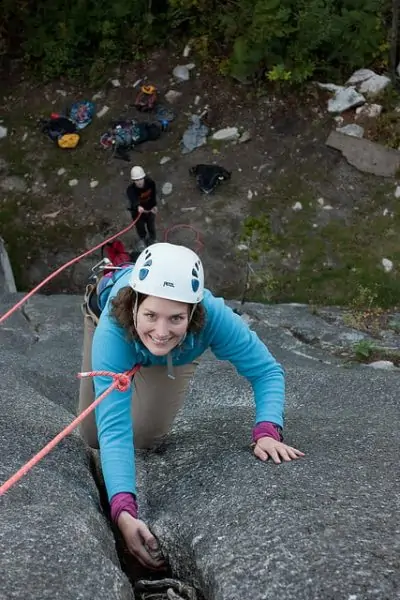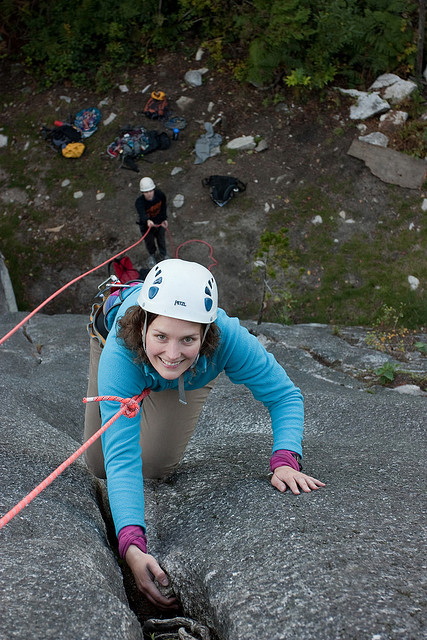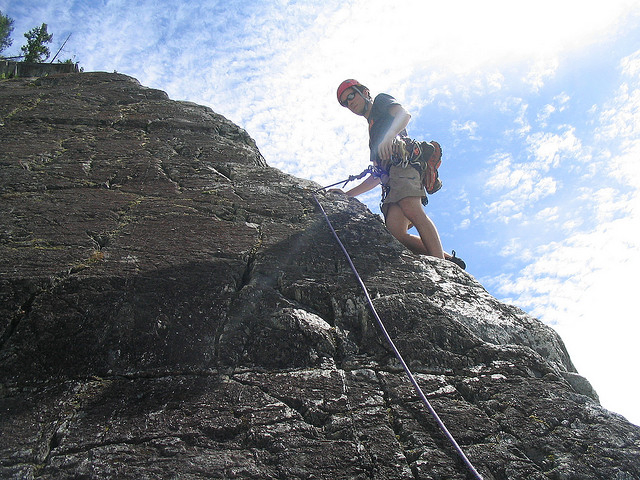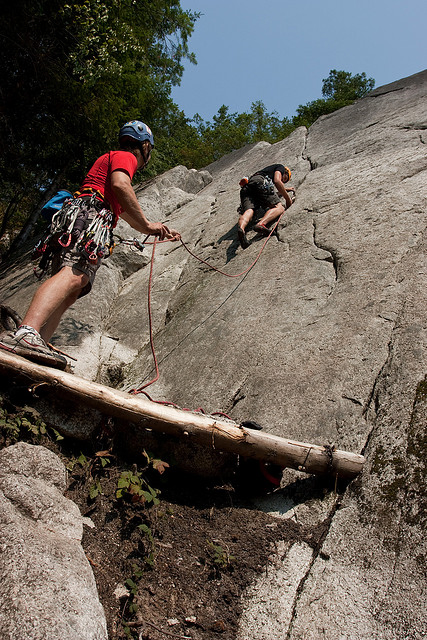I used to rock climb in the great outdoor city of Squamish frequently. Rock climbing was my way to spend time outside, challenge myself physically and mentally, hang out with friends, and have a good time. Interestingly, rock climbing has taught me quite a few things about financial independence.
Before we go any further, there are some rock climbing terms I need to explain.
Top Roping – This is where the rope is set up at top of the climbing route with an anchor system. The climber attaches himself/herself on one end of the rope and the belay partner is on the other end of the rope. As the climber climbs up the route, the belayer at bottom of the climb pulls the rope through a belay device to maintain the same amount of slack in the rope system. Top roping is very safe, assuming the anchor system is set up properly and the belayer is paying attention.
Lead Climbing – This is where the climber ascend the route with the rope trailing behind him/her. The climber clips the rope into a protection periodically as he/she climbs up. The belayer must feed the rope as the climber climbs; the belayer must also pay at attention to make sure to catch the climber if there’s a fall. One should only lead climb when one knows exactly what he/she is doing.
Sport climbing – This is a variant of lead climbing where the protections on the route are pre-drilled by someone that established the climbing route. The climber uses quickdraws to attach the rope to the protection. Once at end of the route, the climber has two options. With the first option, the climber can set up a rappel system at the top, rappel down, and take out the quickdraws on the way down. With the second option, the climber sets up a belaying station at top of the climb, belays the partner while the partner climbs up and takes down the quickdraws, then both partners find walk down via a trial or rappel.
Trad climbing (short of traditional climbing) – This is another variant of lead climbing where the climber places protections as he/she ascends up the route. With the new trad gear, when climber finishes the route, he/she descents and removes all the protection gear or the belayer ascends the route (seconding) and removes all the protection gear. This means once the protections are removed, whoever climbs the route next will see a blank wall.
It’s interesting to note that there are many similarities between rock climbing and quest for financial independence. The outcome for both is highly dependent on the participant(s). So what has rock climbing has taught me about financial independence?
Communication is key
It doesn’t matter if you’re top roping or leading, your life is dependent on your belay partner whenever you are attached to the rope. While having a full trust in your partner is very important, it is more important to have good communication with your partner. When you’re high up on a route, you often can’t hear or see each other. How does your partner know that you want to be lowered? Or that you’ve finished the route? Or you want to take a rest? Or that you’re ready for him/her to second up the route in a lead climb scenario? That’s why you need to establish a communication system prior to ascending the route and constantly communicate with each other. Same thing applies on your quest for financial independence with a partner. Both of you need to be on the same page. The two of you must share the same goals and have the same vision on how to achieve these goals. Regular communication about your quest for financial independence is essential. Are there anything that can be improved, like savings rate, or investment strategies? What about having some side hustles to increase the overall income? What about discussing potential pass income streams? Becoming financial independence is a journey. Along the way, there will be challenges and difficulties. The only way to get through these challenges and difficulties with your partner is to discuss and determine agreeable solutions. If the two do not have good communication, you may end up drifting apart and perhaps breaking up. This is why Mrs. T and I talk about our quest for financial independence every regularly and discuss how we can improve.
Commit mentally
Rock climbing requires a lot of physical endurance, especially when you’re doing a multi-pitched route (ascent of a climbing route with more than one stop at a belay station, typically because the rope is too short to do the entire route). Whether it’s an easy climb or a hard climb, you need to make that sure you’re committed mentally. Other than being belayed for safety measure, you’re completely on your own as you ascend up the route. Contrary to popular belief, your belayer cannot pull you up during a climb. So whether you complete the route or not is entirely up to you. When you’re on the crux (most difficult part) of a route, self-doubt may set in, especially if you have taken a fall or two. You must commit mentally or you can easily give up on the climb. Similarly, the financial independence journey requires mental commitment. Becoming financial independent is not something you can achieve in a few months or a few years. It takes time and commitment to get to the end goal. Without mental commitment, you can easily give up on the goal of becoming financially free after a few years into the journey. This is why I give a lot of kudos whenever I see people that achieved financial independence, or have been on this journey for many many years.
Self challenge
As mentioned above, when you’re ascending a route, you’re on your own, challenging yourself both physically and mentally. You’re climbing because you wanted to, not because someone’s pushing you to do it. Similarly, becoming financial independence is a self-declared challenge. Nobody cares if you are financial independence or not. You’re doing this for yourself because you want a better future.
Failures are OK
Falls are very typically when it comes to rock climbing. I’ve taken my shares of falls, both top roping and leading. The first few lead falls were scary as hell because I had no idea what to anticipate. When it comes to lead falls, you could fall by a lot, especially when you’re by a protection, about to clip the rope in. Why? First of all, since you are pulling the rope to clip it into the protection, there’s a lot of slack in the rope. Second because you’re by a protection, this means that you’re at least 3 metres (~9 feet) from the last protection. If you fall at this time, it means you can fall by more than 6 metres (~18 feet). After taking a few lead falls, I realized that falls are OK and it’s part of the sport. Professional rock climbers quite often run-out their protections on harder routes, meaning when they fall, they could fall by 10 metres (30 feet) or more.
When it comes to the quest for financial independence, we will endure small failures along the journey. For example, one might invest in a rental property only to find out 2 or 3 years in that the property requires too much managing or that the property is not generating any passive income. One might invest in a business hoping to generate passive income only to find out that he/she does not have the personality to own and operate a business. Whatever the failures are, it is OK to encounter them, as long as we learn from the experience and manage the potential losses properly. As someone once told me… failures are what defines us, raising up from a failure will only bring positives.
It’s OK to take a rest
Sometimes your arms get tired during a climb. There’s no shame to find a spot on the route and take a short breather. Reaching financial independence is a multi-year process, it’s certainly not a one day or one month process. Because it is such a long process, we may find ourselves needing some rests to re-focus and re-evaluate our goals. It’s totally OK to take a rest and relax a bit.
Learn constantly and don’t be afraid of ask questions
There are a lot of things one can learn when it comes to rock climbing. For examples, how to belay properly, how to set up an anchor system, how to rappel, how to lead climb, how to place trad protections, and etc. While some of these things can be learnt from books, many of them require lessons from other more experienced climbers. When I started climbing, I followed other more experienced climbers than me in order to learn how they do things. When their anchor systems looked different than the ones I set up, I would ask them why; when they led a route using trad gear, I would volunteer to second up the route to take out the protections, so I could learn in real time how they placed the protections. I would ask a lot of questions and ready to absorb as much knowledge as possible.
Same thing applies to financial independence. To achieve financial independence, we all must have passive income equal or greater than our expenses. There are many different types of passive income and we must learn which ones are suited best for us. With Mrs. T and I, we feel most comfortable with generating passive income through dividend stock investing. We’ve read a lot of books on investing and dividend investing; we also read a large number of personal finance and investing blogs; we also ask fellow bloggers questions whenever we have one. After following the PF blogosphere for a number of years, I’ve learned that everyone in the community is willing to help and provide advise. I believe we should all forget self-pride and help each other.
Have fun while at it
I rock climb because I enjoy the sport, the company, and spend time outside. Even when not climbing, it is fun socializing with friends. The financial independence journey is just the same. We all need to have some fun while on this journey. As harsh as it can sound, I think it’s important to take the time to enjoy our lives now because we can’t be certain what’s going to happen tomorrow. While figuring out what we want to do after achieving financial independence is important, not being financially free should not prevent us from doing things that we enjoy and have fun. Want to paint when financial independent? Don’t wait, start painting now. Want to travel and explore the world when financially independent? Don’t wait, start traveling to different part of the world a few weeks each year. Stop depriving ourselves from having fun in our lives, we all need to live a little. 🙂
Dear readers, is there any activities that taught you about financial independence?





I love this! We wrote a post this past summer about how FI is like mountain climbing… great minds think alike. 😉 Just like in rock climbing, with mountaineering and with FI, you’re choosing to go the less-traveled, harder way, but the way with the best view! I just wish that we could have a top rope at our disposal in finances! That crash back in ’08 was a reminder that it’s possible to fall a lot farther than 10 or 15 feet… but with patience, and if you don’t panic, you can eventually come back from that.
Hi our next life,
Great minds think alike hehe. I love mountaineering as well, especially when it requires traveling on a glacier.
I don’t have any upper body strength. I used to climb tree a lot when I was little as we had a farm. But rock climbing is super hard, I can’t even do a true push up. (I used to play badminton 4 hours straight, I’m playing tennis, and other sport, too, but rock climbing is hard.) It looks so much fun though, the feeling that you’re on top of the world after you reach the peak is priceless. LOL 🙂
Surprisingly rock climbing does not require much upper body strength. You need to use a lot of lower body strength and be good at balancing. A lot of girls actually are better climbers than guys because they relay on their feet. Guys have a tendency to power things through.
Hi Tawcan! That’s an extreme activity. My husband enjoys rock climbing. Whenever he comes back, he feels like he can face any financial challenges. It really helps him have confidence and determination.
Hi Diana,
That’s awesome to hear!
I haven’t done rock climbing and I am so excited about it. I am glad that it taught you many financial lessons. In every activity, there is always a set of rules that we should follow just like in finances. And, one important aspect is that there is someone who is knowledgeable or an expert that we should consult so that the activity we are doing becomes easy and can guarantee results.
Hi Jayson,
I suppose the same lessons can be learned from different sports as well. That’s why it’s great to participate in sports, especially when you are younger as they teach you a lot of life lessons.
I attempted to go rock climbing once (I was probably 15ish) and barely got anywhere and haven’t done it again. Luckily, I haven’t treated financial independence in the same way. Love the analogy you put together!
I am intrigued about rock climbing and would give it another try. Now just need to find people and a place to do it around here!
Haha that’s good that you didn’t treat FI the same way as rock climbing. It does take a bit of attempts to be somewhat good at rock climbing. It’s a fun sport to try.
Love the parallels you’ve drawn here between rock-climbing and financial independence. Golf is one activity that I often draw many lessons from relating to investing, finances and life in general. And couldn’t agree more with your final message of making time for these things now. You don’t need to be retired, waiting until you can do these activities all day every day – just make time for them now!!
Hi Jason,
Making time for things now is very important. Unfortunately so many of us just keep looking forward and forget about “now.”
Thanks for sharing Tawcan. Great post. Lets keep enjoying this awesome life of ours. Glad you’re having a good time. It’s nice to have hobbies. I would love to go snowboarding as it’s very thrilling to glide down the mountain but I havn’t been able to go for a couple of years because of the kids. Gotta spend time with the girlz and I’ll make time when the time comes.
Take care and keep hustling it up. Cheers.
Hi Dividend Hustler,
I hear you on the snowboarding. Have missed the ski season for the last couple of years because of Baby T. Hopefully will make it to the mountains this ski season.
Nice analogy Tawcan, but my dislike of heights keeps me on the ground. It’s not falling that’s scary, it’s the sudden stop at the end 🙂
Surfing has taught me the most about investing…..and myself. Hence the motivation for the blog name. I don’t get to go much anymore, but I need to work on putting my life back in order. I hope you have a great weekend.
-Bryan
Hi Bryan,
I’m sure surfing has taught you a few things about investing. It’s quite surprising how much sports can teach you about life and investing.
Cool analogy. But I think we are going to keep our feet firmly on the ground, thank you very much 😉
Hi Team CF,
Haha good one. 😀
Very interesting perspective! I don’t know much, if anything, about climbing. But you sure made me very curious and excited as we might try it during our RV trip. Looks like something hard but fun, my favorite type of activities… just like FI like you demonstrated.
Cheers,
Mike
Hi Mike,
Climbing is a lot of fun, definitely give it a try, especially top roping.
It’s always interesting to see how other topics/concepts can relate to something that’s seemingly unrelated, such as rock climbing and financial independence.
I’ve top roped before and it was fun but that was probably 15 years ago. Would love to go again at some point but hiking will have to suffice for now.
Hi JC,
Hiking is a great activity as well. I was surprised to see how rock climbing taught me about financial independence, hence for this interesting post. 😀